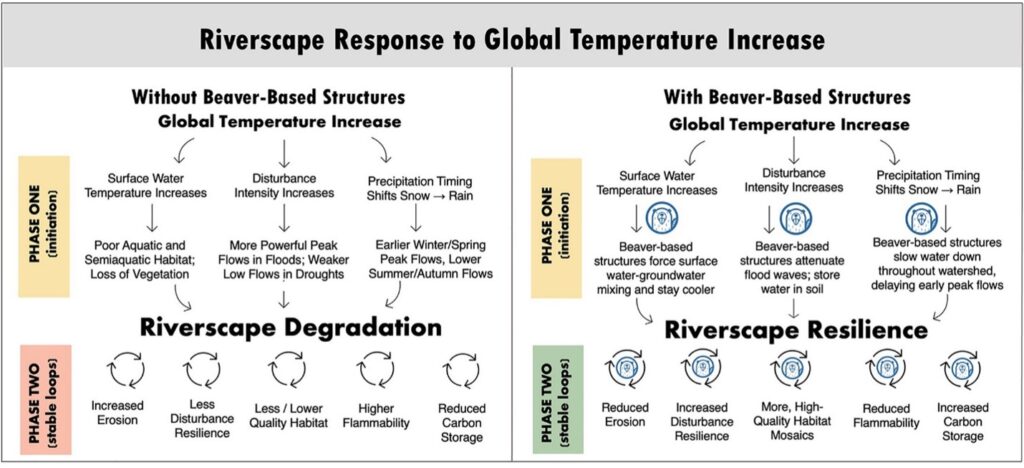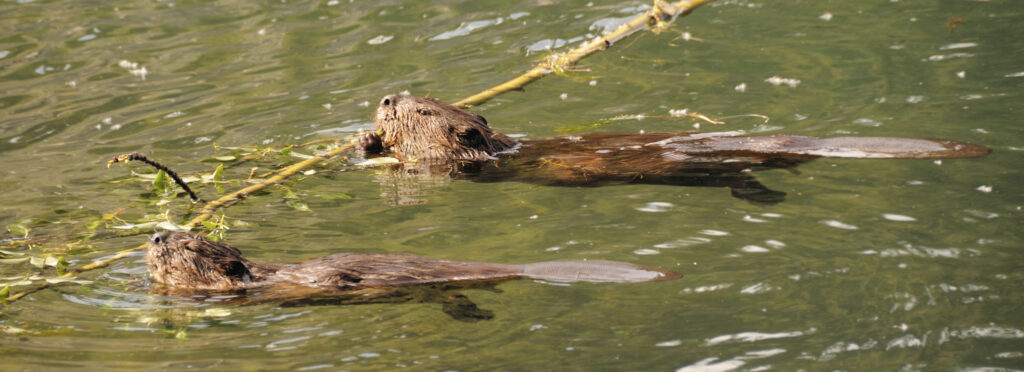The Benefits of Beavers – Nature’s Engineers
Scientists regard beavers as a “keystone species”—a species that creates biodiversity by modifying the environment in a way that benefits the ecosystem and encourages the presence of other species. These large, brown, aquatic mammals were once ubiquitous in the American West, building dams, creating ponds and expanding wetlands—thus shaping the landscape, purifying water, preventing large-scale flooding and providing habitat for many other water loving species. 
Much of the westward expansion and exploration of North America was driven by the quest for beaver pelts, which were used for beaver skin hats, clothing and blankets; and consequently, beaver were hunted to near extinction. As the beaver population diminished and human settlement increased, the habitat and wetland valleys that resulted from beaver activity slowly deteriorated. In recent years, beavers have gradually returned to the landscape, but beaver recovery has been slowed by drought conditions, lack of habitat and quality food, forcing beavers to risk land travel where they are vulnerable to predation.
Research suggests a return of Oregon’s original “landscape shapers” can slowly return watershed health and resilience over time. In a three-year study in a valley ecosystem in Rocky Mountain National Park, researchers found beaver dams built on the river changed the direction of groundwater flow in the valley. The changes caused water to infiltrate the riverbanks and flow underground toward the sides of the valley, instead of down the center of the valley, elevating soil moisture in a way that mimics historic 100-year floods. Additionally, dams built away from natural river channels further redirect water across the valley, enhancing the depth, extent, and duration of inundation associated with smaller floods; they also elevate the water table to sustain plant and animal life during the dry summer season.
Surprisingly, these researchers found beaver dams greatly enhanced hydrologic processes during the peak flow and low flow periods, suggesting that beaver can create and maintain environments suitable for the formation and persistence of wetlands downstream as well as their more notable upstream impacts.

Beaver dams are gaining popularity as a low-tech, low-cost strategy to build climate resiliency. They slow and store water that can be accessed by riparian vegetation during dry periods, effectively protecting riparian ecosystems from droughts. Beaver-dammed riparian corridors are relatively unaffected by wildfire when compared to similar riparian corridors without beaver damming.
Read more about natural beaver recovery at https://beaverworksoregon.org/natural-beaver-recovery/.
Fun Facts about Beavers:
- Based on the fossil records, the smallest extinct beaver species was the size of a muskrat, and the largest may have reached the size of a black bear (five to six times as large as today’s North American beavers).

- Five Iroquois Nations launched the “Beaver Wars” in the mid-1860s to take control of this lucrative fur trade.
- North American beaver were saved from extinction principally by a sudden change in style, as beaver hats lost popularity.
- Castor from beaver scent glands is used in some classic perfumes: Emeraude, Chanel Antaeus, Lancôme Caractère, Givenchy III, Shalimar and others.
- Beaver dams can reach heights of seven feet and lengths of 1,000 yards. A one-half mile long beaver dam in Alberta, Canada can be seen from space.
- Beaver pairs mate for life and form nuclear families of adults, yearlings and kits.
- Beaver can remain submerged under water for up to 15 minutes.
- Beaver use their tails both to signal danger by slapping the surface of the water and as a location for fat storage.
- The beaver is the state animal of Oregon.



